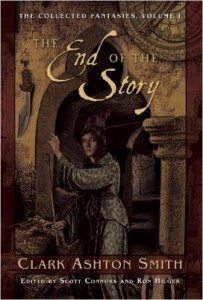
Edited by Scott Connors and Ron Hilger
Night Shade Books
September, 2015
Reviewed by Michael R. Collings
The first in a five-volume series, The End of the Story: The Collected Fantasies of Clark Ashton Smith, first appeared in hardcover in January 2007. Long difficult to locate—and expensive, with price tags ranging from $140 for a used copy to $650 for a new one—the book is now available in trade paperback, complete with twenty-four stories, restored to their original pulp-magazine forms, published in chronological order. They represent Smith’s development as a prose author over a five-year period, 1925-1930.
Also included are story notes by the editors, giving names and locations of source texts where available; publication backgrounds, along with details of composition; comments by Smith about the stories; frequent remarks by H.P. Lovecraft, often from correspondence with Smith; and additional information that illuminates and enriches the readings. Appendix Two provides a second published ending for “The Satyr”; and Appendix Three, a prose-poem, “From the Crypts of Memory.” The volume concludes with a bibliography of original publications and notes on reprints.
Clark Ashton Smith (1893-1961) was a friend, correspondent, and early follower of Lovecraft—often referred to by HPL in mythos-code as “Klarkash-ton”—and one of those most consistently credited with expanding Lovecraft’s Cosmic Mythos. He shared a number of interests with Lovecraft, but the most immediately striking connection is in their love of language, sometimes seemingly for its own sake.
Initially a poet, Smith brought to his prose an intensity, a passion for the exact word no matter how archaic or arcane. For him, “quinquangular” functions in ways that the more prosaic “pentangular” cannot, to say nothing of the blunt “five-sided.” His long, complex, carefully balanced and nuanced sentences reflect the same ardor for linguistic beauty … and through that beauty, additional eeriness, wonder, and hideousness.
No matter the creatures, the landscapes, the characters, Smith’s prose imbues them with a special weirdness, not only in their conceptions—which are remarkable and inventive—but in their descriptions. As with Lovecraft, to remove the extraordinary vocabulary and replace his polished structures with post-Hemingway curtness, and the stories become pamphlets, their horrors dissipating with the breeze. Like Lovecraft—and, for me, like John Milton in Paradise Lost—Smith almost cries out for slow, loving reading (aloud if possible) of his oratorical cadences.
Or, perhaps better put, readers will gain most from the stories in The End of the Story by relaxing, entering into the worlds of Clark Ashton Smith, and letting his unusual uses of English flow around and through them.
For long-time readers of Smith, The End of the Story provides the first installment in a series that makes readily available all of his weird stories at a reasonable price. For newcomers, it is an invaluable introduction to the works and worlds of a remarkable imagination. Highly recommended.








